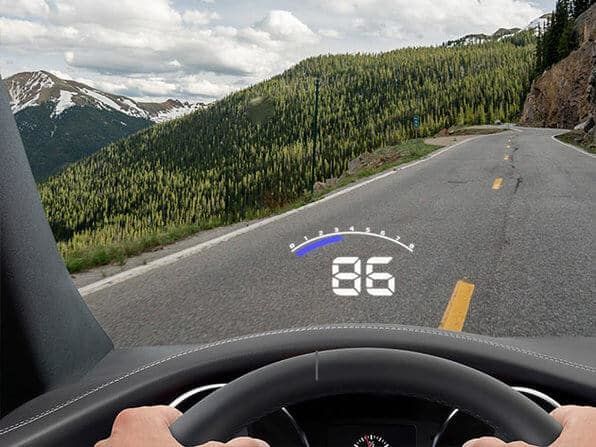
The Popular Mechanics Auto Smartphone Heads Up Display is a great way to keep your eyes on the road and avoid distractions from your phone. It connects to your smartphone via a HUD app to display information from your smartphone on your dashboard. To prevent any accidental movement, the head unit is secured to the dashboard using a non-slip mat. In addition to the device itself, the package includes a reflective screen protector and a user guide.
Smartphone heads-up display
When you need to take a quick look at directions for installation of a HUD in your vehicle, consider following the Popular Mechanics Smartphone Heads Up Display instructions. This kit includes a display for your smartphone and a mat that is non-slip to protect it. The unit measures three by six inches and comes in a hanging bag. Install the HUD by carefully following the instructions.
Most smartphones accept HUD apps, which work with most vehicles. A HUD can add hundreds of dollars to the vehicle's cost. A HUD is an important safety feature that can add a lot of cost. You might consider a third-party device if you are looking for a HUD system in your vehicle. These devices aren't as efficient as HUDs that are built into vehicles.
Requirements
The cockpit's HUD is crucial, especially when safety-critical maneuvers or time are involved. Without an HUD, pilots would have to refocus on both the interior and exterior of the cockpit in order to see information clearly. High-quality HUDs are designed to support avionics such as radar and cameras, so that the pilot can see his information without refocusing his eyes.

FAQ
What is the difference between an automotive technician and a mechanic?
The two are similar but not identical. A mechanic repairs cars while an automotive technician does maintenance on them.
A mechanic must possess good manual dexterity, and be able perform simple tasks efficiently. A mechanic must be able diagnose and fix problems quickly and accurately.
An automotive technician must be more technically proficient than a mechanic. They should be able read blueprints and use tools like drills and wrenches.
They must also be able to carry out complex procedures safely. They must also be familiar with different types of engines and electrical systems.
They must also be able to understand how various parts interact with each other.
As a result, mechanics typically make less than technicians. However, both careers offer great opportunities.
What qualifications do you need to be a truck-mechanic?
Although you don’t have formal qualifications, you have extensive experience with engines and trucks. Your expertise is invaluable because you know how quickly and efficiently to diagnose problems.
You also have an excellent knowledge of diesel technology which will help you to understand what parts are needed to repair our vehicles.
How long does an automotive course take?
An automotive course lasts for three years.
The first year focuses on theory and learning about cars. The second year is dedicated towards practical training. This includes learning how to drive, fix engine problems, and doing other maintenance jobs around your car. You will spend the final year working in a local garage to gain real-world experience.
Are you looking for a career as an automotive mechanic?
Automotive is an exciting industry filled with opportunities for people who are committed to excellence. This field requires hard work and the willingness to learn from others.
Because you will be spending most of your time communicating with customers and employees, you will need excellent communication skills. It's important to be flexible and willing to travel. This will make commutes difficult.
Take classes at community colleges or universities if you're interested to work in automotive. Many schools offer programs specific to students interested in sales, auto repair, or customer service.
Mechanical engineering is a good choice if you are interested in pursuing a degree. It's possible to get a bachelor's degree in just four years.
In addition, many companies will hire graduates straight out of school. So it's wise to start looking for employment while you still have the chance to study part-time.
Once you've completed your education, you'll probably need to complete some form of training before being able to take up a position as an automotive technician.
This means that you will need to pass tests such as the Automotive Excellence (ASE) certification exam. This test covers topics like engine maintenance, brakes system, suspension, and many other subjects.
After passing the ASE test you can apply for a National Institute for Automotive Service Excellence (NIASE) license.
You can perform repairs on private cars by obtaining a license. You'll be paid based upon the number of services provided.
Not all states require licensing. However, licensing is required for anyone who plans to work outside the home state.
Some states don’t issue licenses until a certain amount has been completed. If you are one of these people, you might need to look for another alternative.
Statistics
- 52% of Mechanics in the United States think their salaries are enough for the cost of living in their area. (indeed.com)
- The U.S. Bureau of Labor Statistics (BLS) reports that the job outlook for automotive service technicians and mechanics is expected to decline by 4% from 2019 to 2029. (indeed.com)
- There were 749,900 jobs available for automotive service technicians and mechanics in 2016, which is expected to grow by six percent through 2026. (jobhero.com)
External Links
How To
How to properly diagnose and repair your vehicle
The symptoms of your vehicle are the first thing you need to look at in order to determine whether it is in dire need of repairs. Next, you can follow these steps in order to diagnose your car.
-
Check engine lights. The dashboard light indicators, including the engine light, oil pressure gauge, battery light indicator, coolant temperature gauge and RPM gauge, should be checked. If any of these indicators have been flashing continuously for several days it could mean that there is something wrong with your vehicle.
-
Check the treads of your tires. Tires that are worn can cause issues with handling and braking. Also, inspect the treads of your wheels. They should be clean and smooth. The best way to do this is to remove the wheels and take them off. Use a flashlight to see how well the treads are worn.
-
Pay attention to the level of your brake fluid. Keep track of the brake fluid level in your vehicle. This helps ensure that your brakes operate properly. If your brake fluid level is low they might not work properly when you apply pressure.
-
Make sure to test the suspension system. It is common for vehicles to have a suspension system which absorbs shocks or vibrations. It improves control and allows for smoother accelerations or decelerations. A suspension problem can cause your vehicle to feel wobbly and shake uncontrollably. To determine whether your vehicle may have a suspension issue, you can try to put weight on the rear or front axle and watch the movement.
-
Examine the steering column. The steering columns are what connect the steering knob to the rest. Steering columns can be damaged by accidents. If yours feels loose or shaky, you should replace it.
-
Observe the exhaust pipe. The exhaust pipe helps move gases from a combustion chamber into the atmosphere. Your cabin will be effected if your exhaust pipe cracks or leaks. Additionally, your tailpipe should be fixed immediately if it is bent.
-
Look under your hood. Take a look underneath the hood to find any strange or unusual items. You could have fluids leaking from the engine. In addition, if you notice an unusual smell coming from your engine compartment, you should contact a professional technician.
-
Check the air filter. The air filter in your vehicle collects dirt and dust from the environment. A dirty filter can lead to a poor vehicle's performance. Replace your air filter regularly.
-
Check the fan belt. Your vehicle's fan belt connects the engine to the transmission. If the fanbel breaks, your engine won't turn. It is easy to replace the belt. All you need are a screwdriver & pliers.
-
You should inspect the radiator and hoses. The radiator-hose carries water to the engine. It can become cracked or damaged and leak hot liquid onto your engine. The hose can be repaired with a pair or needle-nosepliers, and a wire brush.
-
You should inspect the windshield wipers. Windshield wipers use electricity to remove snow and rain. They can leave streaks on your windows glass if they stop working. The solution is to change the washer fluid.
-
Check the battery cables. Your car's electrical system is powered by batteries. If you are replacing batteries, disconnect the negative cord first. Failure to do so can damage your alternator.
-
Be sure to check your headlights. The headlights provide illumination for the road ahead. It can lead to poor visibility if they aren't working properly. Check the bulbs to see if they've burned out.
-
Be sure to check the lights. If you approach other drivers at night, lights will warn them. It could cause distraction and even lead to an accident if it doesn't work.
-
Make sure you check your brakes. Brakes will reduce the speed of your car in case of an accident. If the brakes fail to work correctly, your car could lose control and collide with another vehicle.
-
Check the oil regularly. Your engine will stay lubricated by the oil. It protects metal parts and prevents them from wearing too quickly. It is recommended that the oil be changed every other month.